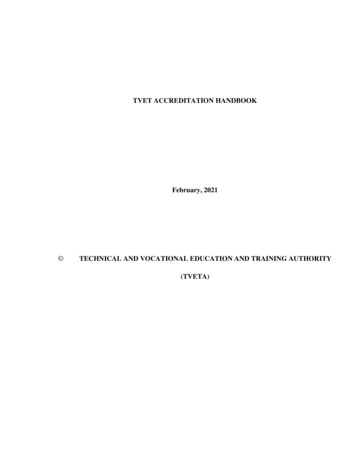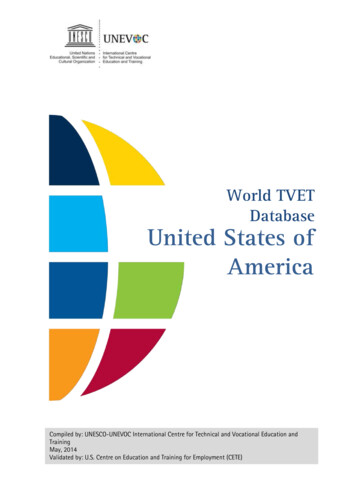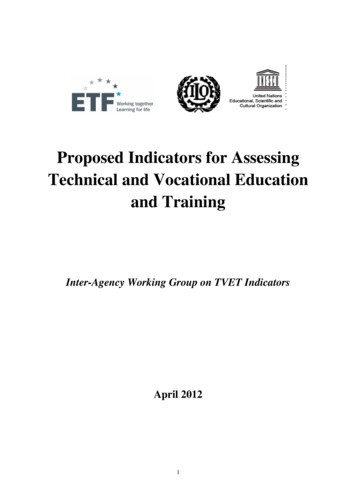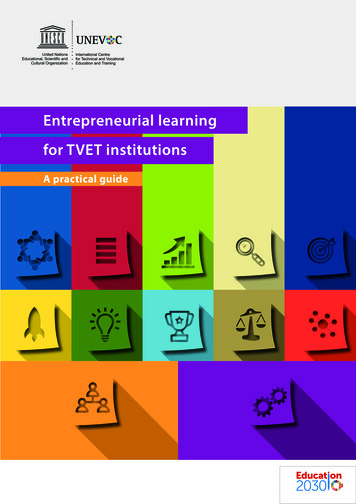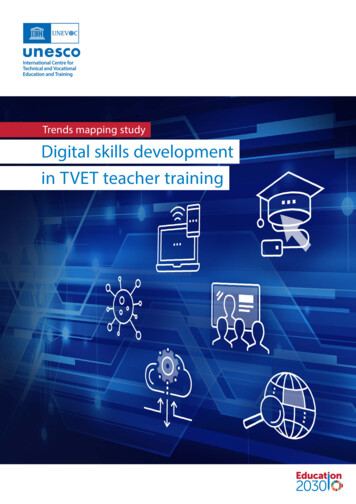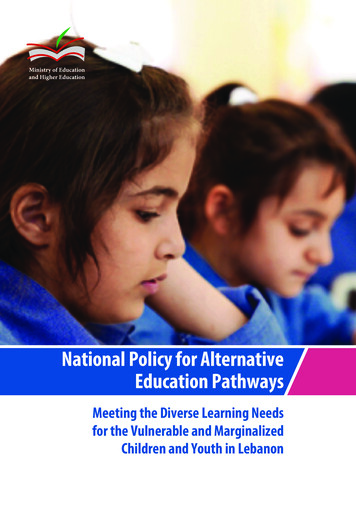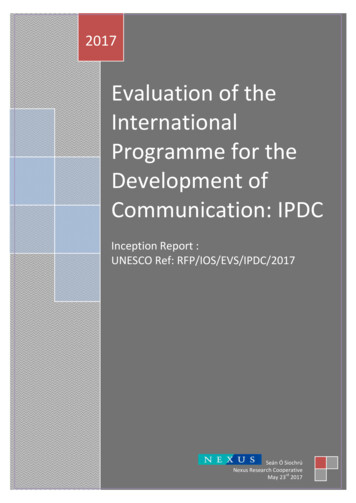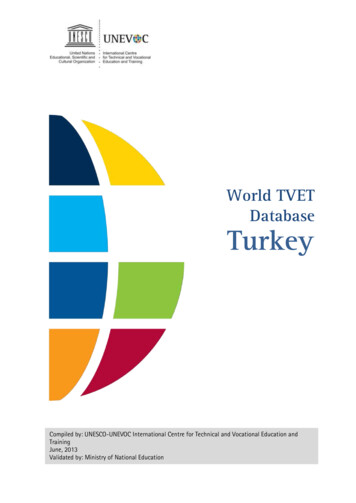
Transcription
World TVETDatabaseTurkeyCompiled by: UNESCO-UNEVOC International Centre for Technical and Vocational Education andTrainingJune, 2013Validated by: Ministry of National Education
World TVET Database TurkeyJune, 2013Compiled byUNESCO-UNEVOC International Centre forTechnical and Vocational Education and TrainingUN CampusPlatz der Vereinten Nationen 153113 BonnGermanyTel: 49 228 815 0100Fax: 49 228 815 0199www.unevoc.unesco.orgunevoc@unesco.orgCountry profiles are compiled from a variety of national and international sources and havebeen informed and validated by UNEVOC Centres in the country or other TVET nationalauthorities.The designations employed and the presentations of material throughout this report do notimply the expression of any opinion whatsoever on the part of UNESCO concerning the legalstatus of any country, territory, city or area or of its authorities, or concerning the delimitationof its frontiers or boundaries.UNEVOC/2013/TVETDB/TUR/1 UNESCO 2015All rights reserved2 Compiled by UNESCO-UNEVOC (http://www.unevoc.unesco.org/)
World TVET Database TurkeyJune, 2013ContentsAbbreviations .41. TVET mission, strategy and legislation .62. TVET formal, non-formal and informal systems .73. Governance and financing . 144. TVET teachers and trainers . 185. Qualifications and Qualifications Frameworks . 186. Current reforms, major projects and challenges . 217. Links to UNEVOC centres and TVET institutions . 238. References and further reading . 233 Compiled by UNESCO-UNEVOC (http://www.unevoc.unesco.org/)
World TVET Database TurkeyJune, 2013AbbreviationsEQFEuropean Qualification FrameworkETFEuropean Training FoundationFATIHMovement of Enhancing Opportunities and Improving TechnologiesHECHigher Education Council of TurkeyMoNETurkish Ministry of National EducationNQSNational Qualifications SystemTOBB ETU University of Economics and TechnologyTOBBTOBBUnion of Chambers and Commodity Exchanges of TurkeyTQFTurkish Qualification FrameworkTQMTotal Quality ManagementUYEPStrengthening Vocational Qualifications Authority (VQA) andQualifications System (NQS) in Turkey ProjectVECsVocational Education CentresVQAVocational Qualifications AuthorityYÖKHigher Education Council4 Compiled by UNESCO-UNEVOC (http://www.unevoc.unesco.org/)National
World TVET Database TurkeyJune, 2013TVETipedia GlossaryBelow are listed TVET terms mentioned in this report. Click on a term to read its definitions onthe UNESCO-UNEVOC TVETipedia icationCommunity-based education/trainingCompetence/yCompulsory educationContinuing an qualifications framework for lifelong learningFormal Education And TrainingGeneral educationHigher educationIn-company trainingInformal LearningInitial TVETJobLabour forceLabour marketLifelong Learning5 Compiled by UNESCO-UNEVOC (http://www.unevoc.unesco.org/)MonitoringNational qualificationNational Qualifications FrameworkNon-formal educationOccupational standardOn-the-job trainingOpen education/learningPrior learningProgrammeQualificationQualityQuality AssuranceSocial PartnersStakeholderTeacherTeacher In VETTertiary EducationTraineeTrainerTraining StandardTVETUpper secondary education
World TVET Database TurkeyJune, 2013TurkeyPopulation:Youth population1:Median population age:Annual population growth(2010-2015)2:78,666,000 (2015)13,051,000 (2015)29.8 (2015)1.69%Data OpenStreetMap Design Mapbox1. TVET mission, strategy and legislationTVET strategyThe Ministry of National Education (MoNE) recognises the increasing importance of TVET.It aims to base TVET on: demands and requirements of the labour market;a participatory-approach;international employability of TVET graduates; andcontinuous development and quality-improvement.TVET legislation The Constitution of 1982 (Art. 10,24,42,62,130, 131) stipulates all basic responsibilitiesof the State with regard to education and training. The Basic Law of National Education No. 1739 of 1973 (amended by Law No. 2842 andLaw No. 4306) specifies objectives, basic principles and general structure of education.It outlines requirements for education institutions at all levels; teaching staff; schoolinfrastructure; material and equipment; as well as duties and responsibilities of relevantbodies. The Apprenticeship and Vocational Training Law No. 3308 of 1986 (amended byVocational Education Law No. 4702) was adopted with the aim to improve TVET. Law No. 5544 of 2006 stipulates the creation of the Vocational Qualification Authorityfor the purpose of establishing a national qualifications framework for TVET based onnational and international occupational standards. The Non-Formal Education Institutions Decree of 2006 regulates activities of nonformal education.1Population aged 14-25All statistics compiled from the United Nation’s Population Division’s World Population Prospects, the2015 Revision (http://esa.un.org/unpd/wpp/DVD/)26 Compiled by UNESCO-UNEVOC (http://www.unevoc.unesco.org/)
World TVET Database TurkeyJune, 2013 Law No. 4702 of 2001 amends exiting laws and stipulates the creation of Vocationaland Technical Education Zones that comprise of TVET upper secondary institutions. Itgrants access for graduates of TVET upper secondary schools to two-year tertiary leveleducation. The Higher Education Law No. 2547 of 1981 outlines goals and principles of highereducation. It defines principles related to the administration and management of highereducation institutions. The Law reforms higher education and incorporates teachertraining schools and institute of education into the system. Primary Education and Education Law, no 6287 dated March 3, 2012.2. TVET formal, non-formal and informal systemsScheme compiled by UNESCO-UNEVOC.7 Compiled by UNESCO-UNEVOC (http://www.unevoc.unesco.org/)
World TVET Database TurkeyJune, 2013Formal educational services at all educational levels are provided substantially (more than 90%)by public education institutions. Private education institutions also exist. Individuals,corporations or other types of institutions (such as associations, foundations) can open and runprivate schools at pre-primary, primary and secondary levels. Private education institutions aresubject to the same regulations with public institutions in terms of educational arrangementsand certification (curricula, teacher qualifications, length of school day/week/year, assessment,progression, diploma etc.). At higher education level, only 'foundations' can run private, not-forprofit, and institutions. Public funds can be provided for private higher education institutionswithin some limits upon meeting certain criteria. Although private higher education institutionsare substantially autonomous in terms of their administration and management, they aresubject to the same regulations regarding educational standards with public institutions.Administrative legislation and supervision related to formal and non-formal education (exceptfor higher education) are under the responsibility of MoNE.MoNE is responsible for preparing the curriculum, maintaining coordination betweeneducational institutions, construction of school buildings etc. Educational activities in theprovinces are organised by the Provincial Directorates of Education appointed by the Minister.Supervision of educational institutions is carried out at both central and regional (local orprovincial) level. The supervision of primary education institutions is performed at provinciallevel by primary education inspectors, while inspectors delegated by the MoNE supervisesecondary education institutions. Higher education institutions are autonomous for purposes ofeducation and research. However, they have to submit annual reports to Higher EducationCouncil (YÖK) which is responsible for the planning and coordination of higher education.Institutions are monitored at least once a year by Higher Education Supervisory Board acting onbehalf of the YÖK.The Turkish National Education System is determined by National Education Basic Act No. 1739,which consists of two main parts, namely “formal education” and “non-formal education”.Formal TVET systemUpper Secondary (General & Vocational) EducationUpper secondary education includes all education institutions of a general or vocational andtechnical character with duration of at least four years following lower secondary education.The objectives of upper secondary education are to give students a common minimum overallknowledge, to familiarise them with problems of the individual and society and to seeksolutions, to ensure that they gain the awareness that shall contribute to the socio-economicand cultural development of the country and to prepare them for both higher education and aprofession or for life and employment, in line with their interests and aptitudes.8 Compiled by UNESCO-UNEVOC (http://www.unevoc.unesco.org/)
World TVET Database TurkeyJune, 2013There are two types of upper secondary education: general and vocational–technical Secondaryeducation schools last a minimum of 4 years including 9th- and 12th grades and cover the agerange from 14 to 17. Some institutions have a 5–year duration, including a foreign languagepreparation grade. Both general education and vocational–technical education includeinstitutions with predominant foreign language education, such as Anatolian High Schools,Anatolian Vocational High Schools etc. The basic difference of these institutions from others isthe increased number of foreign language courses and instruction of some courses in naturalsciences in foreign language. General and vocational–technical secondary education hasinstitution diversity, with more than 30 types of institutions.The TVET system in Turkey includes two main dimensions: theoretical (school training) andpractical (in-company training). Vocational education policies and activities are mostly carriedout by the MoNE within the framework of Law No. 3308, which came into force in 1986 andLaw No. 4702 of 2001, which brought about changes to the system, establishing new andstrong links of co-operation with industry and commerce. The vocational education systemincludes: Vocational and technical high schools providing training in 228 occupations and givingaccess or leading to the qualification of specialised worker and technician;Apprenticeship training, which is a combination of mainly practical training provided inenterprises and theoretical training provided in vocational education centres; and9 Compiled by UNESCO-UNEVOC (http://www.unevoc.unesco.org/)
World TVET Database TurkeyJune, 2013 Non-formal education is provided primarily through vocational education centres. Nonformal education provides educational services in line with the general aims and basicprinciples of national education to citizens who have never entered or who are at acertain level of the formal education system or who have left formal education.The provision of TVET is centralised. Frame curricula are determined at national level, and areapproved by the National Board of Education. Provincial Directorates of the Ministry oversee theTVET provision in each of the province and informing the Ministry.MoNE has been developing modular TVET curricula since 1993. In particular, through EU fundedTVET project, competency based modular TVET curricula development studies have beenintensified since 2002. In this context the programmes of grades 9-10-11-12 in 17 job familiesand 64 branches have been developed within the context of the Project (2002-2007) andapproved by the Board of Education.At the moment, based on the feedback and changing needs of the labour market, approximately7000 module booklets covering 62 job families and 228 branches representing all sectors inTurkey are being utilised for TVET teaching:Vocational and technical education institutions educate students for business and professionalbranches in line with the objectives of general secondary education and prepare them for highereducation. The secondary education institutions offering vocational and technical traininginclude compulsory courses in the 9th grade, an Information and Communication Technologycourse and an elective course of three hours. The pupils are allocated to job families in the 10thgrade and occupational branch in the 11th grade and attend to these branches in the 12thgrade and graduate.10 Compiled by UNESCO-UNEVOC (http://www.unevoc.unesco.org/)
World TVET Database TurkeyJune, 2013School/Institution and Program TypesThe branch courses in secondary education institutions offering vocational and technicaleducation consist of courses developing competencies towards various professions. Furthermore,each branch consists of various sub-branches. Anatolian Technical High School and technicalSchool are excluded from this generalisation. The weekly timetables and curriculumsimplemented in Anatolian technical high schools and technical high schools are similar with thegeneral high schools as of the common general education courses and branch courses of naturalsciences branch. The present branches in vocational and technical education institutions can becategorised as follows: Industrial and technical branches: Apparel, textile technologies, olive technology, andcomputer aided industrial modelling, decorative arts, automotive technologies, furnitureand decoration, metal technology, machine technology, information technologies,apparel machinery maintenance and repair, electric technologies, electronictechnologies, industrial casting, nourishment technology, construction technology,plastic arts and design, plastics technology, etc.Branches related to trade and tourism: office management and secretary, accountingand finance, insurance trade and risk management, computers, marketing, cateringservices, accommodation services, travel agency, travel, recreational services, tourism,journalism, public relations and promotion, radio, cinema and television, etc.11 Compiled by UNESCO-UNEVOC (http://www.unevoc.unesco.org/)
World TVET Database TurkeyJune, 2013 Branches related to social services: Skin care and hairdressing, child development andeducation, organisation services, etc.There were 228 occupational branches in vocational and technical education institutions at theend of 2012.Open Vocational High SchoolAs a result of feedback received from implementations to date, scientific and technologicaldevelopments, face-to-face education and practical training; it became necessary to establishOpen Vocational High School in order to implement vocational secondary education programsmore effectively which already exist in Open High School programs.Although the Open Vocational High School carries out the same system in terms of formaleducation program content, it is unique and different from the other formal educationinstitutions in terms of structure and functioning. In 2006, along with all high schools OpenVocational High School was also extended to 4 years.Common and elective courses taught in the Open Vocational High School are determined inparallel with the formal education by the Board of Education. Education is delivered through TVand radio and supported by printed materials. Vocational courses are taught face to face.Printed materials are sent to students’ addresses by mail and published as e-books on theinternet as well. Graduates of the middle school enrolled to Open Vocational High School cangraduate in a minimum of 4 years (8 semesters).Higher EducationThe Turkish higher education system consists of ‘universities’ and ‘higher technology institutes’(ISCED 5A-B, 6). All higher education institutions are affiliated to universities/higher technologyinstitutes. The only exception to this are some vocational higher schools run by foundations(ISCED 5B). Presently, there are eight vocational higher schools of this type. Universities/highertechnology institutes consist of vocational schools which provide two year-education leading toan associate degree, faculties (science and literature, engineering, etc.) and vocationallyoriented higher schools with four year-duration leading to bachelor’s degree, faculties (medicineand dentistry) with five-six year-duration leading to master’s degree, the institutes (graduateschools) awarding master’s/doctorate degree. Universities/higher technology institutes may bedivided into two groups in administration and financing: public and private (foundation)universities. The students of foundation higher education institutions constitute only 8.3 percent of all higher education students. The share of graduate students (master and doctorate) offoundation higher institutions is 5.7 %.Non-formal and informal TVET systemsNon-formal educational services are provided by the Directorate General for Lifelong Learningthrough the following institutions; Public Education Centres (Total number : 980)Vocational Education Centres (Total number: 334)12 Compiled by UNESCO-UNEVOC (http://www.unevoc.unesco.org/)
World TVET Database TurkeyJune, 2013 Tourism Education Centres (Total number : 9)Maturation Institutes (15)Open Lower Secondary School, Open Upper Secondary School, Open Vocational andTechnical SchoolNon-formal education is delivered through short courses, public training, apprenticeshiptraining and distance learning in public and private schools which operate under thecoordination of the Ministry of National Education. In accordance with the general objectivesand basic principles of national education, non-formal education covers citizens who have neverentered the formal education system or are at any level of it or have left at that level, and itmay accompany formal education or be independent of it.Apprenticeship trainingAs the duration of compulsory education was prolonged to 12 years, the structure of theapprenticeship training has also changed. Apprenticeship training is a dual training system inwhich theoretical training is given in vocational training centres and practical training is in theworkplace. Students must be lower secondary level graduates and enrolment to Open VocationalHigh School is compulsory. While they continue their upper secondary education in OpenVocational High School; they may attend the apprenticeship programmes in VocationalEducation Centres (VECs). Apprenticeship training is provided for those who have not been ableto continue their education after formal lower secondary education or who have been left outof formal education for various reasons.Public Education CentresEducation activities, carried outside of formal education institutions, take place mainly in publictraining centres throughout the country. These centres offer: Literacy coursesVocational coursesSocio-cultural courses and activitiesA significant development in this respect is Law No.5544, adopted in 2006. As noted in theprevious European Inventory report for Turkey this Law on the Vocational QualificationsAuthority (VQA) indicated the start of a new period regarding the recognition and certificationof professional competences. The Law aims to determine the principles of national qualificationsin technical and vocational fields and to establish the VQA to set up and operate the nationalqualifications system in accordance with the European Qualifications Framework. The law alsostates that, based on a list of questions tailored to each profession, a document or a certificateapproved by the VQA indicating professional (technical or vocational) competency level will beawarded to individuals who succeed in examinations. Although the law does not explicitly statethat this competency certificate can be awarded regardless of where the learning took place,there is an emphasis on lifelong learning and recognition of prior learning and it can beassumed that in general individuals will be awarded the certificates, regardless of the learningprocess. These certificates are different to those awarded through the formal education andtraining system and can currently only be provided via a process of validation. This is becausethe process of aligning the formal and non-formal curricula in relation to the standards is stillongoing. Once the system of standards is established, the qualifications in the formal system13 Compiled by UNESCO-UNEVOC (http://www.unevoc.unesco.org/)
World TVET Database TurkeyJune, 2013will be aligned with those used in the non-formal /informal learning. Thus in the future, oncethe quality assurance of training institutions is completed, formal training institutions will alsobe able to award these secondary-level VET qualifications.3. Governance and financingGovernanceThe MoNE is the main body in charge of education in Turkey. The Ministry supervises all formaland non-formal education, excluding higher education. It administers education at central andlocal levels (provinces /districts). Besides the central unit, MoNE organisational units areestablished in 81 provinces and over 800 districts. Each province has one provincial nationaleducation directorate and every district has one district national education directorate. Thesedirectorates are responsible for executing educational services in their provinces/districts.The Ministry has been restructured by the decree law no. 652, dd.14 September 2011. With thislaw 4 different vocational education directorates within the ministry are merged to form aunique directorate.14 Compiled by UNESCO-UNEVOC (http://www.unevoc.unesco.org/)
World TVET Database TurkeyJune, 2013Below are the tasks of General Directorate of Vocational and Technical Education: To condition and implement policies towards the management of the schools andinstitutions of vocational and technical education and the education of their students.To prepare or outsource the education and training programs, textbooks, educationaltools and equipment of vocational and technical schools and submit them to the Boardof Education.To develop, implement and coordinate the implementation of policies and strategieswhich will enhance vocational and technical education and strengthen educationemployment relationship.To fulfil other tasks given by the minister.Vocational and technical secondary education includes at least 17 different kinds of schools, inaddition to vocational education centres, Open Education as well as special private schools.MoNE is responsible for oversight of all vocational and technical schools whether or not theyare under the jurisdiction of itself. Vocational and technical high schools can be grouped in fivecategories. Vocational and technical education is officially co-educational and boys and girlsattend schools designed for the other gender.Schools affiliated to the MoNE Directorate General for Vocational and Technical Education are: Anatolian Technical High Schools;Technical High Schools;Anatolian Vocational High Schools;Industrial Vocational High Schools and Multi-Programs High Schools;Agricultural Vocational High Schools;Anatolian Meteorological Vocational High School;Anatolian Cadastral Vocational High School;Commercial Vocational High Schools;Anatolian Commercial Vocational High Schools;Anatolian Hotel Management and Tourism Vocational High Schools;Anatolian Mass Communications Vocational Schools;Multi-Programs High Schools;15 Compiled by UNESCO-UNEVOC (http://www.unevoc.unesco.org/)
World TVET Database TurkeyJune, 2013 Justice Vocational High School; andHealth Vocational High Schools.Schools affiliated to the MoNE Directorate for Religious Education: Imam-Hatip Lower and Upper Secondary Schools;Anatolian Imam-Hatip Upper Secondary Schools; andImam-Hatip Open Upper Secondary Schools.Open Education High Schools render services to students who cannot attend formal educationfor any reason, who are over the age of formal education, and who wish to be transferred toopen education high schools while attending a formal high school.The National Council for Education is the highest consultative and decision making-body of theMoNE. It consists of relevant stakeholders and was established to develop the nationaleducation system and improve its quality. The Council convenes every four years and deliversdecisions on education which are implemented after being approved by the Government.The Board of Education provides advice to the Minister on all education-related issues; developsvisions; conducts research; and prepares educational plans, curricula and educational materials.VEC composed of the representatives of Ministries, public institutions and agencies, employersand workers. The VEC takes decisions on the issues of implementation of vocational andtechnical education programmes at all formal, non-formal, apprenticeship educationinstitutions. Council decisions are notified to the Ministry of National Education.More specifically, its tasks include: to identify the educational needs of different sectors and fields on apprenticeshiptraining and vocational education;to provide feedback on the fundamentals and duration of the vocational educationprogrammes;to prepare the drafts of regulations about testing/assessment procedures, establishmentand functioning of vocational education testing/assessment commissions atapprenticeship and enterprises;to prepare contract models for apprentice nominees, apprentices and students receivingvocational education at enterprises;when necessary to set up specialty commissions so as to examine the issues related toapprenticeship and vocational education;to examine the issues delivered by the Ministry about apprenticeship and vocationaleducation and provide feedback;to determine the professionals and places which will be imported or exported to/fromthe implementation field in line with the law on vocational training in enterprises andapprentices; andto keep track on the effects on vocational education of changes in technologicaldevelopments and business life.16 Compiled by UNESCO-UNEVOC (http://www.unevoc.unesco.org/)
World TVET Database TurkeyJune, 2013The Provincial Employment and Vocational Education BoardsThe Provincial Employment and Vocational Education Boards are important mechanisms havingthe potential to produce “local solutions for local problems” by means of social dialoguemethod.Provincial employment and vocational education boards have been created to mobilise localfacilities and resources in the fight against unemployment by providing collaboration and peerlearning between different institutions and organisations. They consist of representatives ofother public authorities, as well as workers, employers and trade organisations, industrychambers and other local organisations representatives. Their tasks are: to determine and monitor the needs of the local labour market;to provide vocational courses in the areas of labour force demand; andto prevent employment loss.Board decisions are final. The Committee prepares the action plans of the decisions taken,determines the responsible institutions, practices and results. The Board meets quarterly.Secretariat duties are carried out jointly by the Provincial Employment Agency and theProvincial Educational Directorate.Both missions are extremely ambitious as they intend to introduce in the Turkish VET systemoutcome-related mechanisms that are considered everywhere as landmarks of moderngovernance. So far (2011) over 215 OS have been prepared in cooperation with social partnersand sector representatives.The Council of Higher Education which is the main planning, coordinating and policy-makingbody in higher education. Higher education institutions are autonomous in education andresearch but have to submit annual reports to the Council.FinancingTVET is funded by allocations in the national budget:YearsMoNE Budget .163.000201239.169.379.190TVET Budget Allocated from the MoNE 0 TL5.562.813.504 TL(excludingReligiousVocationalEducation)TVET 3.089.399.325 TL3.307.287.900 TL17 Compiled by UNESCO-UNEVOC (http://www.unevoc.unesco.org/)
World TVET Database TurkeyJune, 20134. TVET teachers and trainersInitial teacher training programmes for pre-primary, primary, lower and secondary education inTurkey are carried out by the universities and are 4 or 5 years long for pre-primary/primary andsecondary teachers respectively.The Faculty of Technical Education, the Faculty of Vocational Education and the Faculty of Tradeand Tourism Education that used to train teachers for vocational and technical secondaryeducation institutions were closed down and new colleges called Faculty of Technology, Facultyof Art and Design and Faculty of Tourism replaced them on November 13th 2009 following adecision of the Turkish Parliament due to the employability problems that the graduates ofthose schools have faced in recent years and the suggestions of the Higher Education Council ofTurkey (HEC). These new faculties will train engineering students. Additionally, the graduates ofthese facult
Formal educational services at all educational levels are provided substantially (more than 90%) by public education institutions. Private education institutions also exist. Individuals, corporations or other types of institutions (such as associations, foundations) can open and run private schools at pre-primary, primary and secondary levels.

